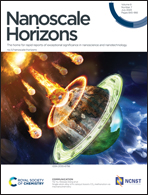Intervalley scattering induced significant reduction in lattice thermal conductivities for phosphorene†
Abstract
The thermal transport properties of buckled phosphorene (β-P) and antimonene (β-Sb) are investigated using first-principles methods. The large acoustic–optical phonon gaps of 3.8 THz and 2.2 THz enable the four-phonon interaction to play an important role in phonon scattering for both β-P and β-Sb. Considering the electron–phonon coupling, the lattice thermal conductivity can further undergo 84% decrease to 4.9 W mK−1 for p-type β-P at n = 5 × 1013 cm−2. By quantitatively describing the scattering probability of electrons in different paths combined with electron–phonon coupling matrix element analysis, it is found that multi-valley features of electronic band structure and strong electron–phonon coupling strength make electrons have strong intervalley scattering behavior in β-P. The former plays an important role in the energy conservation condition of the scattering process, and the latter determines the selection rule. Our work elucidates the contribution of higher-order phonon interactions as well as electron–phonon coupling effects to lattice thermal conductivity, and provides a new idea for finding materials with low lattice thermal conductivity induced by intervalley scattering.



 Please wait while we load your content...
Please wait while we load your content...